Cite this document
(“Comparison of the Form and Style in Things Fall Apart and A Far Cry Essay - 1”, n.d.)
Retrieved from https://studentshare.org/journalism-communication/1428579-comparison-of-the-form-and-style-in-things-fall-apart-and-a-far-cry-from-africa
Retrieved from https://studentshare.org/journalism-communication/1428579-comparison-of-the-form-and-style-in-things-fall-apart-and-a-far-cry-from-africa
(Comparison of the Form and Style in Things Fall Apart and A Far Cry Essay - 1)
https://studentshare.org/journalism-communication/1428579-comparison-of-the-form-and-style-in-things-fall-apart-and-a-far-cry-from-africa.
https://studentshare.org/journalism-communication/1428579-comparison-of-the-form-and-style-in-things-fall-apart-and-a-far-cry-from-africa.
“Comparison of the Form and Style in Things Fall Apart and A Far Cry Essay - 1”, n.d. https://studentshare.org/journalism-communication/1428579-comparison-of-the-form-and-style-in-things-fall-apart-and-a-far-cry-from-africa.


